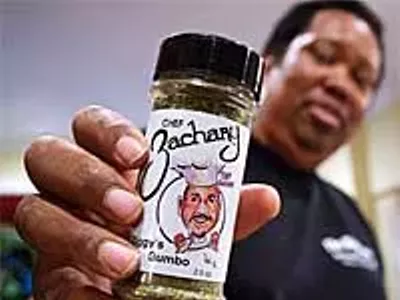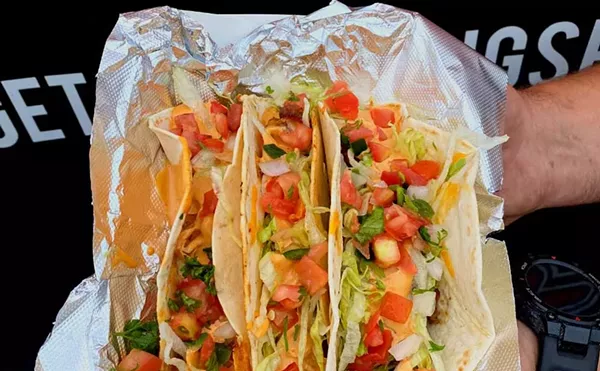
Audio By Carbonatix
[
{
"name": "GPT - Leaderboard - Inline - Content",
"component": "35519556",
"insertPoint": "5th",
"startingPoint": "3",
"requiredCountToDisplay": "3",
"maxInsertions": 100,
"adList": [
{
"adPreset": "LeaderboardInline"
}
]
}
]
We've been there: Low funds and an empty stomach. For young folks living in the city or off at college, it's not uncommon to have to cobble together a meal from what a handful of change will buy at the corner party store. Many of us muddle through and later look back with fondness on our ramen-noodle days.
But some of us grow into bohemians. We realize that the less we spend on food, the less we have to work. The less we have to work, the more we get to do. For bohos, it's liberating to leave behind the frills and trimmings of conventional eating and focus on fundamentals, living parsimoniously and flipping the heartless food industry the bird.
But you don't need to live in a garret to appreciate the wisdom of eating simply and cheaply. Yes, true bohemians are eccentric lentil-soakers, noodle-boilers and corn-poppers, but, in this age of overprocessed and overprepared food, these hobo-to-boho cookshack tips may present a welcome antidote to fads, gadgets and other silliness.
We don't need no stinkin' garlic press: All you really need is a peeler, a can opener, a wooden spoon, a cutting board and three sharp knives — small, medium and large. Leave the inside-the-shell egg scramblers and lettuce spinners to the squares.
Europe's "soul food": When it comes to nutrition, fiber, flavor and price, veggies are values. In fact, after such New World vegetables as potatoes, tomatoes, maize and squash were exported to Europe, the poor began eating better than the wealthy. Medieval lords, their feet swollen with gout, stuffed themselves with meat, fish and wine while the serfs were actually fortified by nutritious Amerindian staples, helping to spark a population explosion.
Tuber time: The humble potato has saved countless lives with its starchy goodness. Sometimes selling for as little as 10 cents a pound, all you need to do is stab the hell out of one, chuck it in the microwave for 10 minutes, slash it open, shower it with chopped chives and sour cream, and you get hundreds of calories, potassium, vitamins C and B6, little cholesterol and no sugar. Slice them in half, rub them with salt and rosemary and bake them for an hour to get a nice roasted flavor.
Roots rock: For snacks, soups and stir-fries, the carrot is essential. For a fuss-free snack, peel carrots and keep them submerged in a glass of water in the refrigerator. Don't be fooled by "baby-cut" carrots — they're mature carrots cut to resemble the real delicacy. Look for mature carrots that snap when bent. Don't pass on its pale cousin, the parsnip.
Use your head: Yes, the smell of cabbage is associated with the tenement house. Sure, broccoli can turn your bowels into bellows. But for those with solitary ways (or with forgiving loved ones), the cabbage family can't be beat for nutrition. Steamed, stir-fried or stewed, these veggies pack a lot of punch.
Bulbs are best: The onion may be the most versatile culinary vegetable. Kept in a cool, dry place, they don't even need refrigeration. Countless boho recipes begin by browning chopped onions in oil. Chopped red onions add spice to salads. Chopped chives are a great topping for tired foods.
Simmer down: Don't boil vegetables. The American table is plagued by the last vestiges of bad English cooking: boiling things until dead. They have already overthrown the practice in Britain, where curry has become the reigning national dish. Why boil away good nutrition? For flavor and texture, steaming or cooking al dente yield the best results. And if you must have baby-food softness in your vegetables, try soups and stews.
Ban the box: Americans occupy the temperate heart of a rich agricultural continent. So why do we often choose to eat like astronauts in space or soldiers in the desert, cracking the seal on mummified meats and factory-dried vegetables? Aside from the occasional box of muffin mix or mac and cheese, stay away.
Do look down: Supermarkets count on shoppers to pick up items that are stocked at the beginning of aisles or at eye level. Walk on and keep your eyes down, looking for the "poor brand."
Sorry, Juiceman: Unless you're fighting a yeast infection and need cranberry juice, or enjoy lugging a few quarts of liquid for exercise, fruit, for fiber and flavor, is preferable. If you must drink juice, get the cheaper frozen concentrate and mix it at home. If you must have liquid juice, get the real thing and not sugared-up "juice drink."
Water: It's almost free. Why drink anything else? Garnish with ice and serve.
Chop-chop: As the old adage goes, you can only get two out of three when it comes to fast, cheap and good. Cheap, quality food takes time. A real boho learns to love chopping vegetables on a cutting board. Who wants to shred their food to a pulp and then clean a food processor? Plus, you get to snack while you chop.
Grow some herb: Even those with a brown thumb can grow the hardier herbs at home. Often, you'll get better results pulling a few leaves off a backyard plant than paying for factory-dried, irradiated powdered spices.
Support your local farmer: Area farmers risk it all each year to provide healthful, nutritious food. Rather than pay the air fare for cardboard vegetables grown far away, reward these local yokels with your patronage. Not only is it fresher, when it's in season it's cheaper. Pinch an extra penny by shopping at farmers' markets when all the vendors are about to leave. They got there at sunup. By the time your hangover has worn off, you can shop cheap and sometimes even pick up stuff for free.
Billions can't be wrong: Nothing can fill you up quite as quickly as rice. It fills the hole when there's nothing else, provides a foundation for stir-fries and curries, and makes a solid side for a meat meal. Get in the habit of starting water on the boil first when cooking so it'll be ready to cook the rice by the time you're halfway through your preparations.
Bean bags: The bags of dried beans in most supermarkets are a sensational value: hundreds of nutritious calories for less than a buck. Best are beans that hold their shape during the soaking process, such as lentils.
In the flesh: Meat is a value because it's government subsidized in this country, but bohos can squeeze even more out of it. It's cheaper when it comes on bones, which can be boiled to make a passable soup stock. Even cheap, lean cuts can be savaged with a fork and marinated for better flavor. Marinade ingredients might include vegetable oil, soy sauce, mustard, pepper or lemon juice.
Pop-up snacks: Forget that microwave stuff — unless you're popping it on the range, you're not living. The bowl of pan-popped popcorn is the bohemian standard, and many a blackened pot has been sacrificed in its pursuit. Why fork over a few bills for fat-soaked chips or cheesy poofs when you can have an Amerindian classic for a quarter a bucket? Get creative with your toppings. Try olive oil and salt, or even lemon-and-pepper salt.
Dollar delights: Ramen noodles can be dressed up for finer things, provided you never use those awful flavor packets they come with. (Even bouillon cubes are preferable.) Everyone who's been to college has their favorite ramen-modification plan. Ramen and tuna can make the world's cheapest casserole.
Super spread: When it comes to peanut butter, bohemian cooks develop a respect for old George Washington Carver. The versatile spread is part of our culinary repertoire from our earliest days in the kitchen. The PBJ is strictly varsity-level, and true boho sandwiches drop the jam entirely. One boho acquaintance's love of the peanut butter and honey sandwich is evident in the slight stickiness to every surface in his apartment.
Go ethnic: If you can't find a farmers market or a food co-op, it can be difficult to get affordable quality produce. Organic retailers are a little high-end for the chump-change set. Luckily, ethnic markets offer excellent produce at reasonable prices. Their customers demand quality — you get to share in it.
Food fluffers: Sometimes, the same old cheap eats get boring. That's where "food fluffers" come in. They add spice to commonplace meals and help make leftovers appetizing. If you want to cook up a Ravi Shankar special but are confounded by Indian powders and spices (and have a bit of extra money to spend), S&B brand Golden Curry products come in dissolvable cubes. Sambal, a ground chili paste, will make even the saddest leftovers palatable; Huy Fong Foods makes an incendiary sambal oelek, available at better supermarkets. The most effective fluffers can be found free at restaurants: mustard and ketchup. Don't sneer: Mustard can bring days-old chili back from the brink.
Be creative: Experiment with new recipes. Cookbooks are usually the cheapest items in a used bookstore. Challenge yourself. Remember, a lack of funds is no excuse for eating poorly.
Boho recipes
$2.50 pasta sauce
Can of tomato paste1 cup chopped onions
1 finely chopped toe of garlic
2 tablespoons olive oil
1 pinch salt
1 tablespoon oregano
1 tablespoon basil
1 can peeled tomatoes
Heat olive oil in a saucepan. Sear garlic by stirring it quickly, then toss in the onions and stir. Just as they are starting to soften and turn brown, add the tomato paste. Watch for it to soften and brown a bit, then add the tomatoes and salt and spices. Bring to a boil and then simmer.
Tastier tuna sandwich
1 can tuna
3 tablespoons salad dressing
2 celery stalks, finely chopped
4 slices of bread
1 teaspoon cumin (optional)
1 teaspoon mustard (optional)
Whisk together tuna, salad dressing, celery. Spread on toasted bread and add a dash of cumin or splork on the mustard. Makes two loaded sandwiches.
Michael Jackman is Metro Times’ copy editor and jack-of-all-trades. Write him at mjackman@metrotimes.com




